DENTAL IMPLANTS
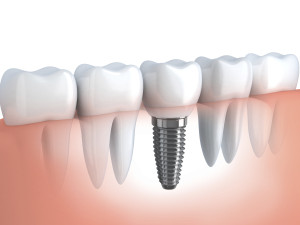
3D Drawing of Human Tooth Implant
How do Dental Implants work?
A dental implant can be compared to an artificial root that acts the same as a real root does. Titanium is what dental implants are commonly made of, a powerful and sufficient metal that the human body accepts. Old solutions to replacing teeth such as bridges and dentures have easily had there places taken by dental implants. Permanent teeth can than be created and put on top as soon as the jawbone heals. In a nutshell, the dental implant is infused in your jawbone acting as a replacement for the root of a missing tooth. A prosthetic tooth is then secured firmly directly on the implant, providing a solution lasting many years to the problem of missing teeth.The Benefits of Dental Implants
- Health and Beauty – Bone loss and bone shrinking are common side effects of a missing tooth. Implant dentistry can put a halt these effects and make sure your face remains in a natural shape.
- Comfortable – Unlike dentures, dental implants are secured tightly to ensure there is no movement or budging. The common negatives of dentures such as poor fit, gum irritation, and pain from exposed nerves are now a thing of the past.
- Confidence – Dental implants will make sure you are never ashamed of your teeth and have to cover your mouth when laughing, smiling, or speaking. You no longer have to worry about eating food that would usually cause you discomfort. You will leave more confident then ever before.
DENTAL EXAMS AND CLEANINGS
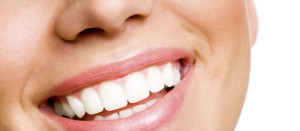
Clean Teeth
Preventing Problems Before They Start
Visiting your dentist regularly for thorough exams and cleanings is vital to the healthiness of your teeth. Although everyday brushing and flossing are needed to keep your teeth clean, The American Dental Association recommends a visit to your dentist every six months to guarantee healthy teeth and a beautiful smile. Visiting your dentist periodically for cleanings and exams can:- Put an end to tooth decay, gum disease and bad breath
- Save money by removing the need of having expensive and rigorous dental procedures
- Keep white teeth by lowering the amount of staining from food and drinks
- Reduce the amount of time in your dentist’s office
- Have a healthy smile that will last a lifetime
The Exam
In a typical exam, your dentist will carefully scan your teeth and gums for any signs of tooth decay, gum disease or any other health problems. It is also common to take X-rays to observe what’s beneath the surface of your teeth and gums. The images are then provided to your dentist and will help them discover any dental issues that are not seen by the naked eye.Professional Cleanings
First, your dentist will inspect your teeth to determine if you have any cavities and to check the condition of any existing fillings. Your dentist will then perform a periodontal exam which studies your gums and makes sure your gums and teeth are connected tightly and that no periodontal disease or bone deterioration is taking place. In the next step, your teeth are carefully cleaned with different tools that eliminate any buildup from your teeth. Your teeth are then flossed with a polishing compound. Let your dentist know immediately if you’re having anxiety at any part of the cleaning as they are not usually painful. Additional options can be provided to make sure that you are comfortable. If tooth decay or gum disease is found, they will inform you and give you tips on how to change your teeth cleaning habits. Antibiotics or other dental treatments might be offered if the case is severe.DIGITAL X-RAYS
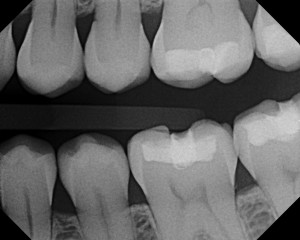
Digital X-Ray
PERIODONTICS
The word periodontal is used to define the tissue that surrounds your teeth. Periodontists perform treatments and surgery in this area, the most common problem being gum disease, usually caused by plaque. Problems in the periodontal area are often discovered after they have already existed for a long time. Regular dental checkups and cleanings will greatly minimize the risk of gum diseases that range anywhere from gingivitis or to a much more severe disease such as periodontists. Thankfully there are treatments currently available for all cases of gum disease. Usual problems that are categorized with gum disease are:- Receding gum lines
- Discolored or deteriorating teeth
- Holes between your teeth and gum tissue
- Infected gum tissue (recognized by discoloration or inflammation)
- Loss of teeth or loss of movement of teeth
SOFT TISSUE LASER THERAPY

Laser Therapy
The periodontal pocket
Periodontal disease is a severe inflammatory disease that is caused by bacterial infection. The inflammation is a result of the body’s response to try to destroy and fend off the harmful bacteria. However, if the situation still lingers, this protective mechanism actually begins to become harmful to the tissues.The periodontal pocket, in periodontal disease, contains several substances that fuel this unhealthy condition.
- Calculus and plaque on the tooth’s surface
- Pathogenic bacteria
- An ulcerated, epithelial lining that contains granulation tissue and bacterial by-products.
What do we need to help with the healing of the pocket?
- All plaque and any other debris on the tooth must be removed to ensure a completely clean surface.
- Decontaminate all bacteria spread over the pocket.
- Curretage: Make a clean and even epithelial lining that doesn’t have tissue tags (epithelial remnants)
- Biostimulation: To initiate the healing process
BONDING/FILLINGS
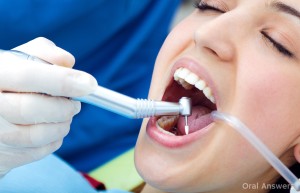
Bonding & Filling
Fillings
The main idea of a “filling” is to replace and restore tooth structure that’s been damaged because of decay or fracture by using a material. We will replace any old or worn out amalgam/metal fillings that have traces of mercury with white fillings (composites) to refresh your smile and teeth and give it a more natural look and feel. Using modern advancements, you will no longer have to go through the embarrassment of having unsightly and unhealthy silver/mercury fillings or metal margins. Get rid of the dark, black appearance in your teeth with new-age tooth-colored resin or other porcelain materials.Bonding is a common solution for:
- Helping restore chipped or cracked teeth
- Reducing unsightly gaps or spaces between teeth
- Hiding discoloration or faded areas
Composite bonding has many advantages:
- It is a quick and easy process that’s over in under a hour.
- It does harm the tooth or change it’s natural shape and is a cheaper alternative.
- Composite resins come in enough different colors to make sure that one of them will match the natural color of your teeth.
TEETH WHITENING
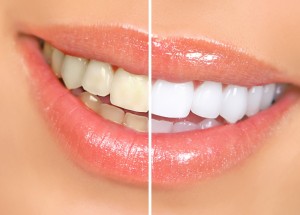
Teeth Whitening Before/After
In-Office Teeth Whitening
The first professional option is in office teeth whitening. Performed in a dental office, an in-office whitening treatment uses a whitening lamp or whitening laser to enhance the effectiveness of the whitening gel by accelerating the peroxide. The Zoom In-Office Whitening System is often considered one of the fastest ways to greatly whiten your teeth. In a little over an hour, this both sufficient and safe system can give you the immediate results you want. A specific kind of light activates the gel which then softly breaks down stains on your teeth which rejuvenate your smile! Zoom Whitening is very safe, especially while under the supervision of a trained dentist. Although, pregnant women and children under the age of 13 are not recommended for this procedure.At-Home Teeth Whitening
Tray Bleaching
Tray bleaching uses both a special kind of tray and gel, both of which are available only through your dentist. The whitening gel is put in custom-fitted trays that fit perfectly each time. The gel breaks down and helps whiten any stained teeth. Unlike strips, this process actually whitens all your natural teeth and is intended to give you the maximum amount of comfortableness. At-home professional tray whitening can take 10-14 days, although you may see results in as few as 3-5 days.Paint-On Teeth Whiteners
Over the counter teeth whiteners do exist, one of them a product called paint-on teeth whiteners. These are purchased over-the-counter and are mostly less expensive but less effective than whitening strips or other professional options. Paint-on teeth whiteners contain of a kind of gel that is enforced to the tooth using a brush. The gel then hardens into a film that coats the teeth, then dissolves in the mouth. It is suggested to talk to a dental professional before use, as is suggested with all teeth whitening options.Teeth Whitening Strips
Thin and flexible plastic (polyethylene) strips that have hydrogen peroxide bleaching capabilities are called whitening strips. They come in kits that include strips for both your upper and lower teeth. Putting the strips over your teeth and pushing them into place will activate the bleaching agent and ensures contact with all of your teeth. These strips are typically worn for 30 minutes a day, twice a day. How long the treatment lasts overall varies.Whitening Toothpaste and Mouthwash
Less expensive options include whitening toothpastes and mouthwashes that have been created specifically to have “whitening capabilities”. It is important to remember that they only affect surface stains, they do not actually lighten the color and shade of the tooth.INVISALIGN
Invisalign® is the clear way of straightening teeth using aligners instead of braces. Aligners can easily be taken off and on and are virtually invisible. This means your teeth can be straightened without anyone knowing; and you can eat and drink anything you want. You can also brush and floss as you would normally do to maintain healthy gums and teeth. Mouth abrasions cease to exist due to the elimination of wires, metals, and brackets. Many of our patients who had never considered traditional braces are now joyfully and comfortably improving their teeth with Invisalign®.WHAT IS INVISALIGN®?
- Straightens your teeth without braces, and without anyone knowing.
- Several clear, removable, custom-made Aligners.
- Does not use any brackets or wires.
- Built to be comftorable.
HOW DOES INVISALIGN® WORK?
- Wear each set of Aligners a few weeks at a time.
- Easily removable for when you need to eat, drink, etc.
- Your teeth will gradually move each week.
- Pay your a doctor a visit every couple of months.
- Total treatment time can be anywhere from 6-15 months.
- Will go through about 18-30 Aligners.
ROOT CANALS
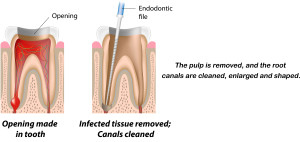
Root Canal Diagram
Dental Health and Root Canals
In the past, a tooth with a diseased nerve meant that it was lost. Today however, with a special dental procedure called root canal treatment, it is possible to save a tooth that has a diseased nerve. Root canals are a relatively simple procedure which is over in about 1-3 office visits. Having a root canal treatment when crucial can save your tooth and overall your smile!What is the function of a root canal?
A tooth’s nerve is not vital to a tooth’s health or function after the tooth has come up through the gums. The only function it provides is to sense if something is hot or cold. Cracked teeth or teeth with cavities are prone to bacteria which can enter through your pulp tissue and can cause an infection inside your tooth. If not treated, an abscess can be caused. If the infected tissue is not dealt with soon, serious swelling can be caused. This injures your jawbones and can negatively effect your overall health. Your tooth may have to be removed if correct treatment is not undergone immediately.What signs show that a root canal treatment may be needed?
Root canal therapy don’t always have to be painful. Some signs that may indicate that you need a root canal are toothaches, pain when chewing, pain in response to anything really hot or really cold, darkening teeth, and swelling and high sensitivity in the gums.What happens during a root canal treatment?
Root canal treatments usually need anywhere from one to three visits to be completed. The first step is the removal of any affected tissue. Next, the inside of the tooth is cleaned and then closed shut. Lastly, dental composite is used to fill the tooth. Sometimes it is suggested to place a crown to harden and shield the tooth from breaking. Regular brushing, flossing, and checkups will make sure your treated tooth will last. Cavities are caused by the enamel(major tissue located in teeth) in your tooth decaying. This decay can eventually dig deep inside your tooth and damage its structure. If the damage is bad enough that a regular filling won’t treat it then a root canal treatment will be used to preserve the tooth and help it retain its old look; whereas in the past the tooth would have to be pulled.Procedure:
- All patients go under anesthesia.
- A dental tool called a dam is to separate the tooth.
- Infected and dead tissue are removed.
- The tooth’s cracks and canals are all cleaned.
- Dental tools are used to reshape the canals.
- The tooth is filled with special and compatible material.
- The opening is temporarily covered.
- Restoring your tooth requires an immediate visit to your dentist.
EMERGENCY DENTAL CARE
You can call our practice anytime in the wake of any dental emergency. If you need immediate attention after we are closed, you can call our emergency phone number where our staff will be able to help you. Dial 911 if our office is unreachable. We’re here to help you any time of the day. Your dental health is important, and we are ready to treat you as soon as possible if that health is ever at risk. You never know when a dental emergency can happen so it’s important to know the correct way to take care of your teeth. Dental emergencies include:- Broken or cracked teeth
- Broken jaw
- A permanent tooth being knocked out
- Painful Toothaches
VENEERS
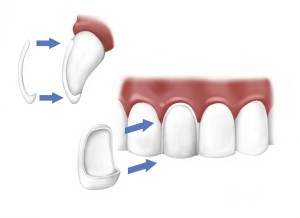
Veneer Diagram
- Spaces in between teeth
- Chipped teeth
- Yellow teeth
- Crooked teeth
IMPLANTS
Without all of your teeth, consuming food can unsettle your bite and cause you pain and restlessness which makes replacing any missing teeth a crucial thing to do. Missing teeth can also cause your mouth too shift and make your face look older. Implants are a life long solution to replace missing teeth. An implant is made to look exactly like a natural tooth, instead that it is actually made up of porcelain and metal. It’s made up of two parts: One is a titanium body that acts as the root, the second part is a tooth-colored crown that is placed directly above the implant. We guarantee that no one will ever suspect that you have a replacement tooth. Implants can also be used to anchor lower dentures that alter when your mouth is in motion. For patients with dentures, implants can replace your teeth in a way that ensures you a natural smile.CROWNS

Crowns & Bridges
BRIDGES
Bridges can also be used to replace missing teeth, help keep your face in natural shape, and help you to not stress over your bite.DENTURES
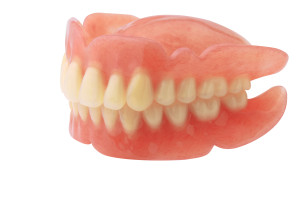
Dentures

